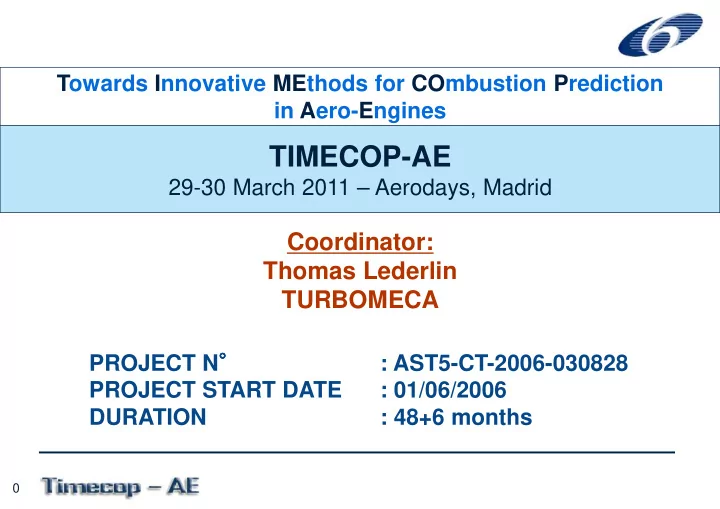

Towards Innovative MEthods for COmbustion Prediction in Aero-Engines TIMECOP-AE 29-30 March 2011 – Aerodays, Madrid Coordinator: Thomas Lederlin TURBOMECA PROJECT N ° : AST5-CT-2006-030828 ° ° ° PROJECT START DATE : 01/06/2006 DURATION : 48+6 months 0
TIMECOP-AE at a glance � Towards Innovative MEthods for COmbustion Prediction • Liquid fuel sprays • Turbulent combustion • Ignition � Summary • 23 partners from 8 countries (France, Germany, Greece, Italy, Netherlands, Poland, Spain, UK) • 4 Work Packages • 48 tasks � Scientific production • 7 test-rigs • 18 CFD codes or modules • 94 technical deliverables validated • 41 publications produced � Simulation results validated • Against experimental data • Through code-to-code comparisons 1
Liquid Kerosene Combustion: 3 Technical Topics � Liquid Fuel sprays � Turbulent combustion Iso-surface of temperature in a generic burner. (Large-Eddy Simulation) � Ignition Iso-surface of temperature in a generic burner. (Large-Eddy Simulation) High speed video visualization of spark ignition and flame luminosity 2
Research Strategy � Objectives of the project • Understand the physical phenomena associated to liquid fuel combustion in an aeronautical engine • Develop high-fidelity modelling tools to reproduce these phenomena � Three levels of experimental test rigs • Experimental facilities aimed at the validation of fundamental works • Experimental facilities aimed at the validation in complex geometries • Two-phase flow generic sector combustor � Three levels of numerical tools • Numerical module • Research code • Industrial code Burner test-rig � Cross-comparisons LES calculation (field of liquid kerosene) RANS calculation (temperature field) 3
Experimental Facilities � 3 validation facilities • Droplet tracking • Detailed flame diagnostics • Visualization of ignition sequences Droplet generator � 3 complex geometries Swirler-nozzle combustion • Liquid fuel spray test-rig • Swirling flows • Optical access � 1 Generic sector combustor • High-pressure facility High-pressure Generic combustor sector 4
Numerical tools � 5 code modules • Droplet tracking • Detailed chemistry calculations • Combustion models � 7 research codes • Experimental facilities aimed at the validation of fundamental works • Experimental facilities aimed at the validation in complex geometries • Two-phase flow generic sector combustor � 6 industrial codes • RANS and LES • Commercial or private codes 5
Main Advances in Liquid Fuel Spray Modelling Before TIMECOP After TIMECOP Experimental lack of accurate measurements detailed gaseous and liquid of droplet size and velocity in phase databases in Level industrial swirling flows industrial burner flows Numerical Lagrangian and monodisperse Polydisperse Eulerian and Eulerian methods available but Lagrangian methods tested Level not tested on industrial on industrial configurations configurations. Assessment of the advantages and drawbacks of each method 6
Advances in Turbulent Combustion Modelling Before TIMECOP After TIMECOP Experimental lack of details in measurements detailed flame on industrial configurations of visualizations and Level reacting swirling flows (e.g. measurements in industrial elevated pressure) . Difficult to configurations (e.g. validate numerical models fuel/flame interaction) (boundary conditions) Numerical Lack of validation of chemistry Assesment of several schemes (reduced chemistry, chemistry schemes, pdf Level tabulated chemistry) methods, pollutant formation methods 7
Advances in Ignition Modelling Before TIMECOP After TIMECOP Experimental � Lack of experimental evidence to visualization of the different describe the ignition phenomenon phases in the ignition process Level Ignition probability maps. � No knowledge on stochasticity of ignition Numerical Level Only semi-empirical ignition models, Real unsteady multi-factor only simple evalaution of the ignition ignition models tested, multi- probability of a burner, no physics models developed, demonstration of the LES unsteady complex sub-models developed application to the ignition phase for LES that treat ignition 8
Conclusions and related projects � A breakthrough in ignition understanding and modelling • Visualizations • Unsteady simulations • Numerical assessment � A milestone in research on engine operability • Injections systems • Ignition methods • Importance of Large-Eddy Simulations • Bottleneck with primary atomisation � To go further: related FP7 projects • KIAI: ignition and instabilities • FIRST: primary atomisation 9
Recommend
More recommend